首先得自己搭建一个kafka,搭建教程请自行百度,本人是使用docker搭建了一个单机版的zookeeper+kafka作为演示,文末会有完整代码包提供给大家下载参考

废话不多说,教程开始
一、老规矩,先在pom.xml中添加kafka相关依赖
<dependency>
<groupId>org.springframework.kafka</groupId>
<artifactId>spring-kafka</artifactId>
</dependency>
二、在application.yml中添加相关配置
spring:
#kafka配置
kafka:
#这里改为你的kafka服务器ip和端口号
bootstrap-servers: 10.24.19.237:9092
#=============== producer =======================
producer:
#如果该值大于零时,表示启用重试失败的发送次数
retries: 0
#每当多个记录被发送到同一分区时,生产者将尝试将记录一起批量处理为更少的请求,默认值为16384(单位字节)
batch-size: 16384
#生产者可用于缓冲等待发送到服务器的记录的内存总字节数,默认值为3355443
buffer-memory: 33554432
#key的Serializer类,实现类实现了接口org.apache.kafka.common.serialization.Serializer
key-serializer: org.apache.kafka.common.serialization.StringSerializer
#value的Serializer类,实现类实现了接口org.apache.kafka.common.serialization.Serializer
value-serializer: org.apache.kafka.common.serialization.StringSerializer
#=============== consumer =======================
consumer:
#用于标识此使用者所属的使用者组的唯一字符串
group-id: test-consumer-group
#当Kafka中没有初始偏移量或者服务器上不再存在当前偏移量时该怎么办,默认值为latest,表示自动将偏移重置为最新的偏移量
#可选的值为latest, earliest, none
auto-offset-reset: earliest
#消费者的偏移量将在后台定期提交,默认值为true
enable-auto-commit: true
#如果'enable-auto-commit'为true,则消费者偏移自动提交给Kafka的频率(以毫秒为单位),默认值为5000。
auto-commit-interval: 100
#密钥的反序列化器类,实现类实现了接口org.apache.kafka.common.serialization.Deserializer
key-deserializer: org.apache.kafka.common.serialization.StringDeserializer
#值的反序列化器类,实现类实现了接口org.apache.kafka.common.serialization.Deserializer
value-deserializer: org.apache.kafka.common.serialization.StringDeserializer
三、添加操作kafka的工具类KafkaUtils.java(这里我只是简单
的
封装了一些方法,大家可以根据需要自行添加需要的方法)
package com.example.study.util;
import com.google.common.collect.Lists;
import org.apache.kafka.clients.admin.*;
import org.apache.kafka.common.TopicPartitionInfo;
import org.springframework.beans.factory.annotation.Autowired;
import org.springframework.beans.factory.annotation.Value;
import org.springframework.kafka.core.KafkaTemplate;
import org.springframework.stereotype.Component;
import javax.annotation.PostConstruct;
import java.util.Collection;
import java.util.HashMap;
import java.util.List;
import java.util.Map;
import java.util.concurrent.ExecutionException;
import java.util.concurrent.atomic.AtomicReference;
import java.util.stream.Collectors;
/**
* 操作kafka的工具类
*
* @author 154594742@qq.com
* @date 2021/3/2 14:52
*/
@Component
public class KafkaUtils {
@Value("${spring.kafka.bootstrap-servers}")
private String springKafkaBootstrapServers;
private AdminClient adminClient;
@Autowired
private KafkaTemplate kafkaTemplate;
/**
* 初始化AdminClient
* '@PostConstruct该注解被用来修饰一个非静态的void()方法。
* 被@PostConstruct修饰的方法会在服务器加载Servlet的时候运行,并且只会被服务器执行一次。
* PostConstruct在构造函数之后执行,init()方法之前执行。
*/
@PostConstruct
private void initAdminClient() {
Map<String, Object> props = new HashMap<>(1);
props.put(AdminClientConfig.BOOTSTRAP_SERVERS_CONFIG, springKafkaBootstrapServers);
adminClient = KafkaAdminClient.create(props);
}
/**
* 新增topic,支持批量
*/
public void createTopic(Collection<NewTopic> newTopics) {
adminClient.createTopics(newTopics);
}
/**
* 删除topic,支持批量
*/
public void deleteTopic(Collection<String> topics) {
adminClient.deleteTopics(topics);
}
/**
* 获取指定topic的信息
*/
public String getTopicInfo(Collection<String> topics) {
AtomicReference<String> info = new AtomicReference<>("");
try {
adminClient.describeTopics(topics).all().get().forEach((topic, description) -> {
for (TopicPartitionInfo partition : description.partitions()) {
info.set(info + partition.toString() + "\n");
}
});
} catch (InterruptedException | ExecutionException e) {
e.printStackTrace();
}
return info.get();
}
/**
* 获取全部topic
*/
public List<String> getAllTopic() {
try {
return adminClient.listTopics().listings().get().stream().map(TopicListing::name).collect(Collectors.toList());
} catch (InterruptedException | ExecutionException e) {
e.printStackTrace();
}
return Lists.newArrayList();
}
/**
* 往topic中发送消息
*/
public void sendMessage(String topic, String message) {
kafkaTemplate.send(topic, message);
}
}
四、添加KafkaController.java作为kafka的demo类
package com.example.study.controller;
import com.example.study.model.vo.ResponseVo;
import com.example.study.util.BuildResponseUtils;
import com.example.study.util.KafkaUtils;
import com.google.common.collect.Lists;
import io.swagger.annotations.Api;
import io.swagger.annotations.ApiOperation;
import lombok.extern.slf4j.Slf4j;
import org.apache.kafka.clients.admin.NewTopic;
import org.springframework.beans.factory.annotation.Autowired;
import org.springframework.kafka.annotation.KafkaListener;
import org.springframework.web.bind.annotation.*;
import java.util.List;
/**
* kafka控制器
*
* @author 154594742@qq.com
* @date 2021/3/2 15:01
*/
@RestController
@Api(tags = "Kafka控制器")
@Slf4j
public class KafkaController {
@Autowired
private KafkaUtils kafkaUtils;
/**
* 新增topic (支持批量,这里就单个作为演示)
*
* @param topic topic
* @return ResponseVo
*/
@ApiOperation("新增topic")
@PostMapping("kafka")
public ResponseVo<?> add(String topic) {
NewTopic newTopic = new NewTopic(topic, 3, (short) 1);
kafkaUtils.createTopic(Lists.newArrayList(newTopic));
return BuildResponseUtils.success();
}
/**
* 查询topic信息 (支持批量,这里就单个作为演示)
*
* @param topic 自增主键
* @return ResponseVo
*/
@ApiOperation("查询topic信息")
@GetMapping("kafka/{topic}")
public ResponseVo<String> getBytTopic(@PathVariable String topic) {
return BuildResponseUtils.buildResponse(kafkaUtils.getTopicInfo(Lists.newArrayList(topic)));
}
/**
* 删除topic (支持批量,这里就单个作为演示)
* (注意:如果topic正在被监听会给人感觉删除不掉(但其实是删除掉后又会被创建))
*
* @param topic topic
* @return ResponseVo
*/
@ApiOperation("删除topic")
@DeleteMapping("kafka/{topic}")
public ResponseVo<?> delete(@PathVariable String topic) {
kafkaUtils.deleteTopic(Lists.newArrayList(topic));
return BuildResponseUtils.success();
}
/**
* 查询所有topic
*
* @return ResponseVo
*/
@ApiOperation("查询所有topic")
@GetMapping("kafka/allTopic")
public ResponseVo<List<String>> getAllTopic() {
return BuildResponseUtils.buildResponse(kafkaUtils.getAllTopic());
}
/**
* 生产者往topic中发送消息demo
*
* @param topic
* @param message
* @return
*/
@ApiOperation("往topic发送消息")
@PostMapping("kafka/message")
public ResponseVo<?> sendMessage(String topic, String message) {
kafkaUtils.sendMessage(topic, message);
return BuildResponseUtils.success();
}
/**
* 消费者示例demo
* <p>
* 基于注解监听多个topic,消费topic中消息
* (注意:如果监听的topic不存在则会自动创建)
*/
@KafkaListener(topics = {"topic1", "topic2", "topic3"})
public void consume(String message) {
log.info("receive msg: " + message);
}
}
五、运行项目,然后访问 http://localhost:8080/swagger-ui.html测试一下效果吧
这三个topic本来是不存在的,这里是由@KafkaListener注解方式监听时自动创建的

1、我们来新增一个名为‘myTopic’的topic试试
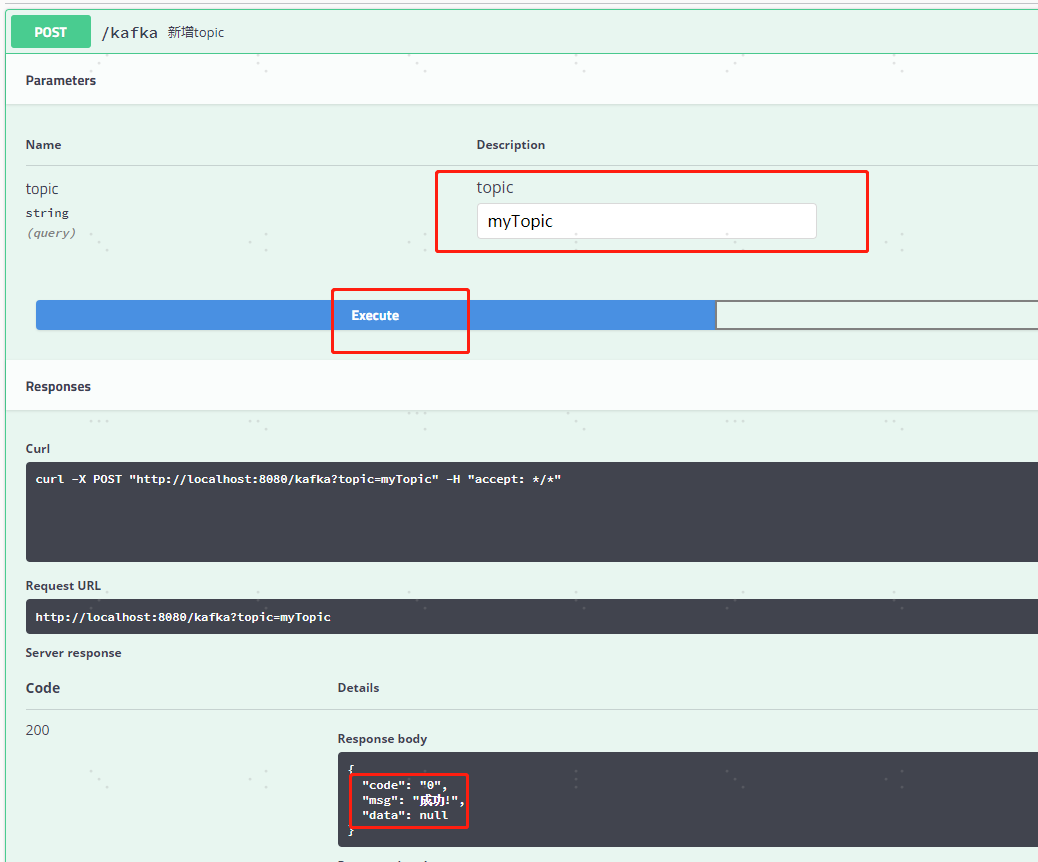
2、再重新查询一下所有的topic发现我们新增topic成功了
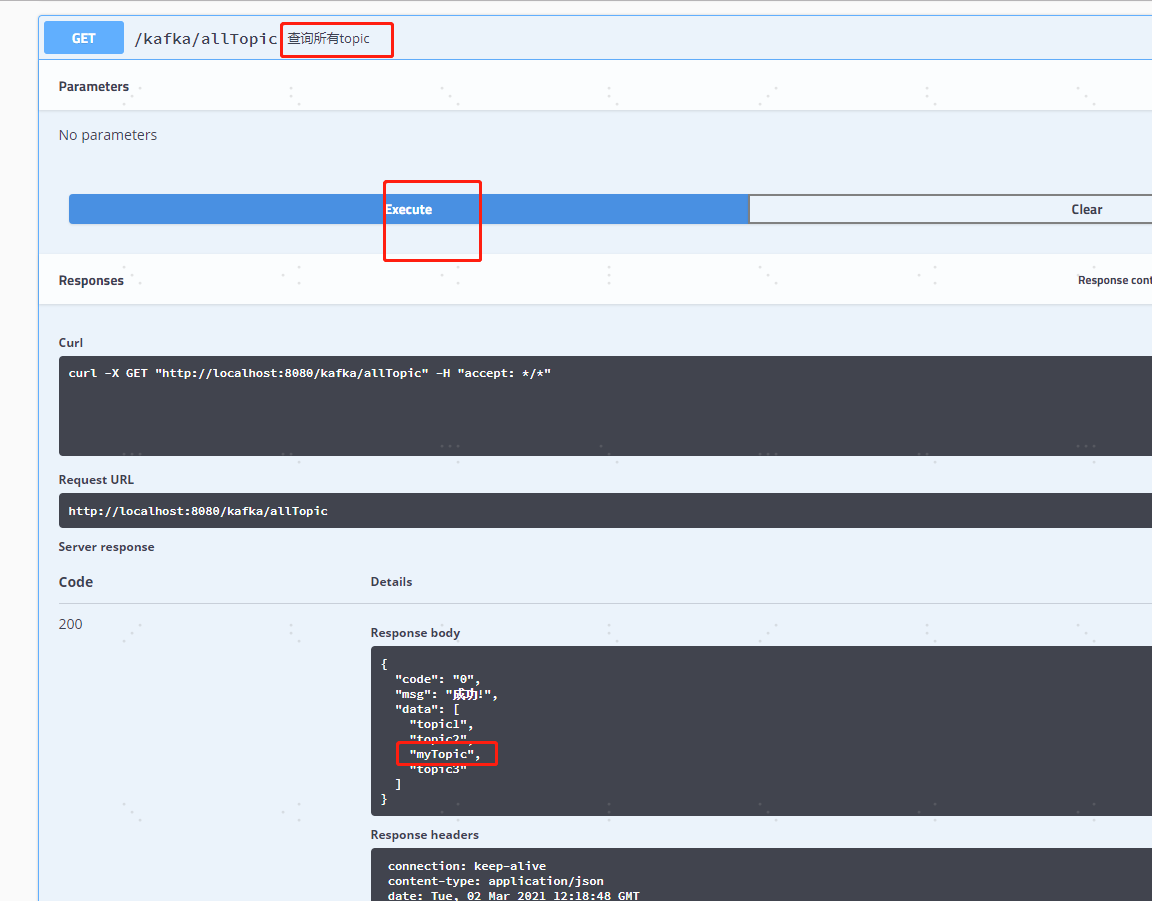
3、接下来我们试试删除一下myTopic和由@KafkaListener注解方式监听时自动创建的topic1
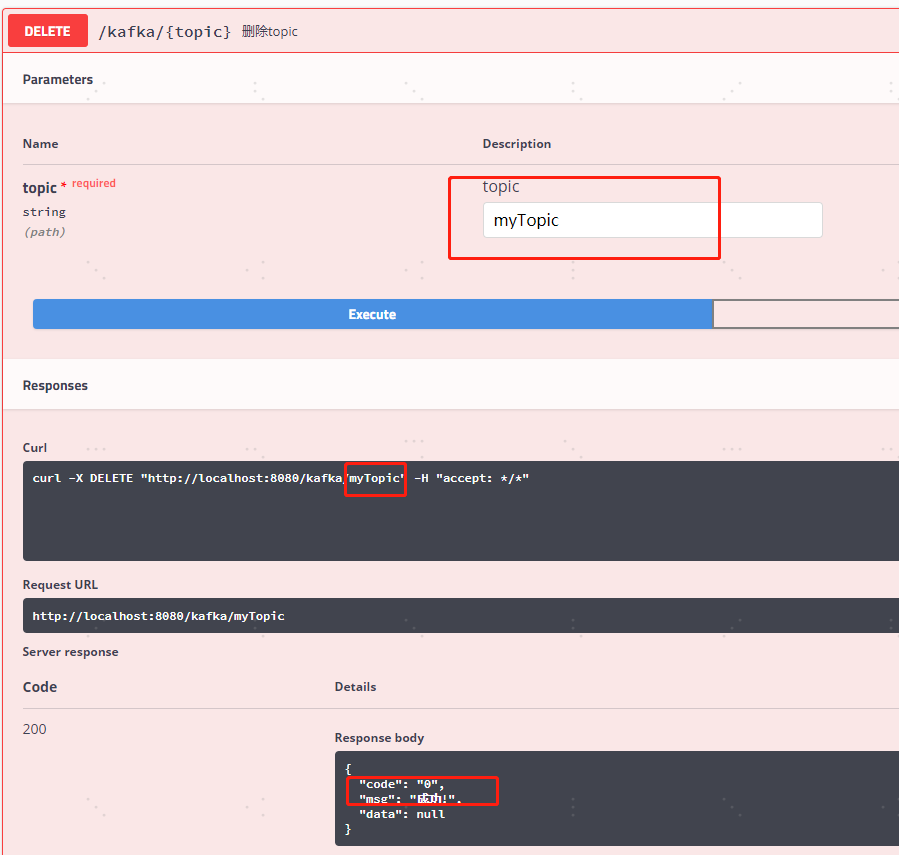

4、我们再查询一下所有的topic发现‘myTopic’被删除掉了,但是‘topic1’并没有被删除掉,原因就是因为‘topic1’正在被监听,删除掉后又会被自动创建,正如我代码的注释中的说明一样

六、我们来试试我们最关心也是最常用的功能,作为生产者发送消息到topic以及作为消费者消费topic中的消息
1、我们先把控制台的日志先清除一下方便待会儿查看效果
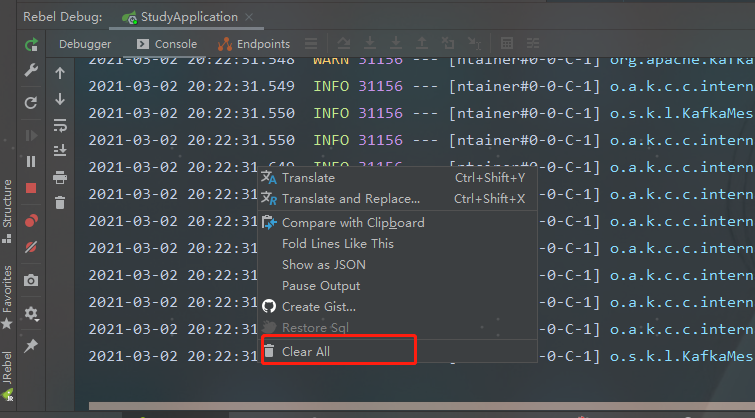
2、我们往正在被监听的”topic1″、”topic2″、”topic3″中的任意一个发送测试消息
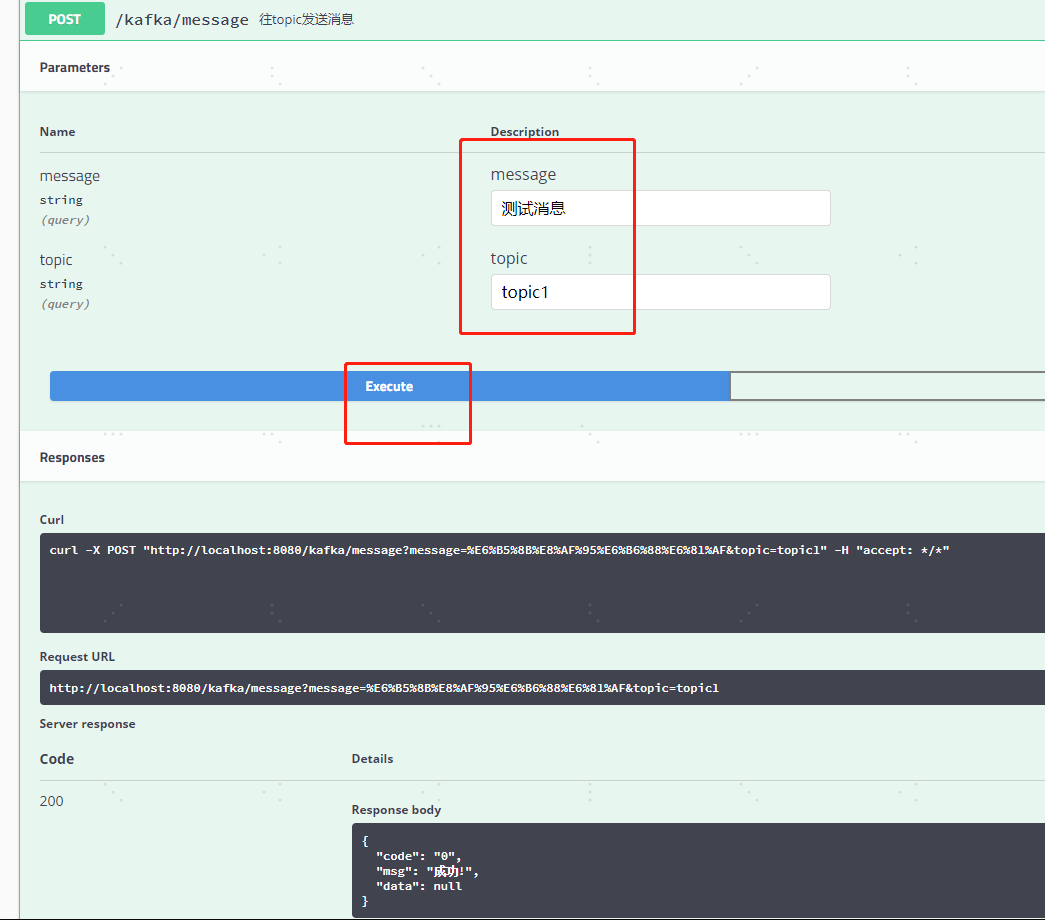
3、查看IDEA控制台发现topic中的消息被监听消费到了,大功告成

原文链接:https://www.cnblogs.com/wqp001/p/14471097.html?utm_source=tuicool&utm_medium=referral
如果觉得本文对你有帮助,可以关注一下我公众号,回复关键字【面试】即可得到一份Java核心知识点整理与一份面试大礼包!另有更多技术干货文章以及相关资料共享,大家一起学习进步!

版权声明:本文为weixin_50205273原创文章,遵循 CC 4.0 BY-SA 版权协议,转载请附上原文出处链接和本声明。